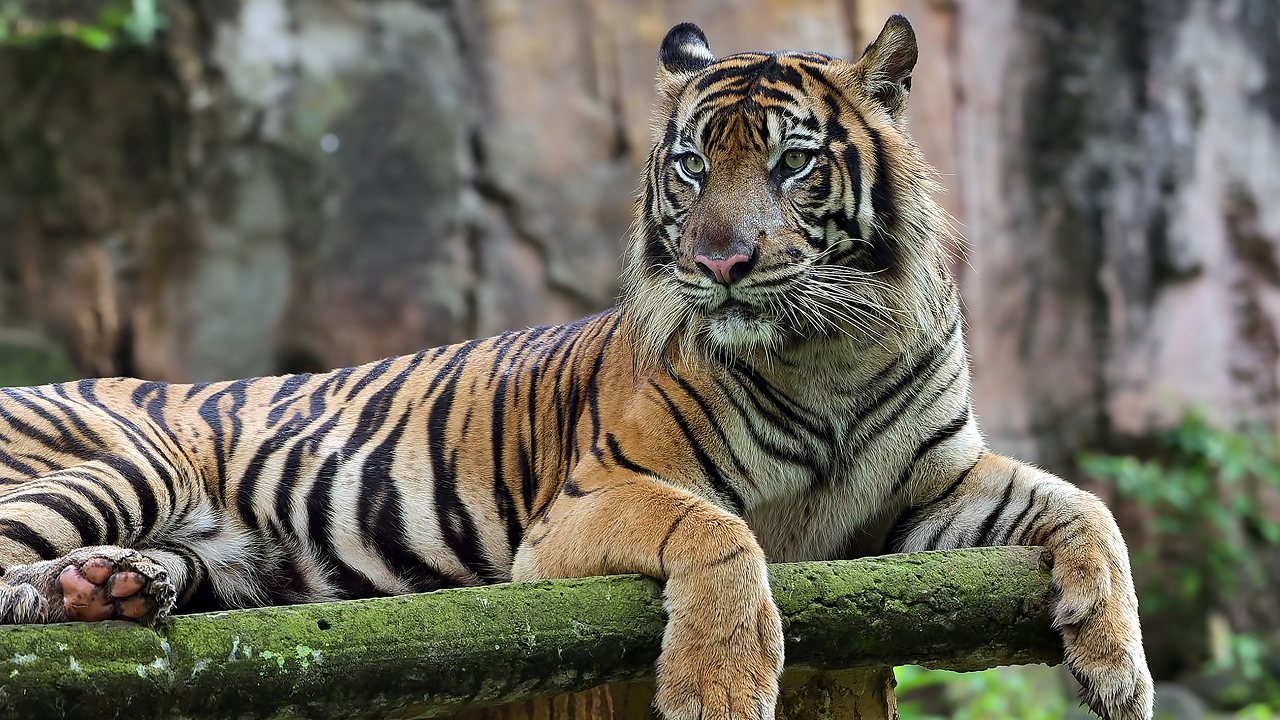The Amazon rainforest is a wet broad forest in the Amazon biome spread over 6.7 million km² that covers most of the Amazon basin of South America. However, this region includes territory belonging to nine nations.
Moreover, the majority of the forest is found within Brazil, with 60% of the rainforest, followed by Peru with 13%, Colombia with 10%, and with minor amounts in Ecuador, Venezuela, Bolivia, Guyana, Suriname, and France.
The estimated proportion of Brazilian species was 9.5% of the world total (95% CI, 8.5 to 11.5%). From this, an estimated known Brazilian biota is 170,000 to 210,000 species.
Additionally, there are 40,000 plant species, 427 mammals, 1294 birds, 378 reptiles, 427 amphibians, and around 3,000 fishes in the Amazon rainforest.
Table of Contents
The Amazon contains millions of different kinds of species. Most of them are still undescribed, and some of them are the world’s most unusual wildlife.
The Most Common Species of Amazon Rainforest
In the heart of the enchanting Amazon Rainforest, a bustling community of diverse creatures thrives. Each contributes to the vibrant tapestry of this lush ecosystem.
Here is the list of the most common species and their type in the Amazon rain-forest:
| Specie | Type |
|---|---|
| Boa Constrictor | Snake |
| Scarlet Macaw | Bird |
| Howler Monkey | Monkey |
| Green Lguana | Lizard |
| Jaguar | Cat |
| Green Iguana | Monkey |
| Tapir Mammal | Rhino |
| Caiman | Crocodile |
| Capybara | Rodent |
| Toco Toucan | Bird |
Let’s take a closer look at some remarkable residents who call this dense jungle home:
Boa Constrictor

Deep within the tangled foliage, the Boa Constrictor, a silent guardian, gracefully maneuvers through the underbrush.
With its sleek, muscular body, it moves like a shadow, embodying the mystique of the rainforest.
It is poisonous and pungent in attacking by masking the ground with its vibrant colors matching the earth.
An adept hunter, the Boa Constrictor is an essential part of the delicate balance that sustains life in this captivating realm.
Scarlet Macaw
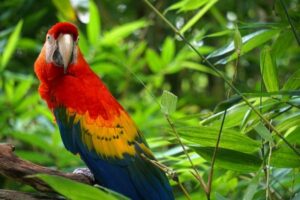
Among the kaleidoscope of colors, the Scarlet Macaw soars gracefully.
Its vibrant plumage leaves a trail of brilliance against the verdant backdrop. Another species in the Macaw family is Blue Macaw, also found in the Amazon rainforests.
Related Pick: Vanishing Beauty: Are Blue Macaws Extinct?
Symbolizing the exquisite beauty that arises from the harmonious coexistence of its inhabitants.
With an intelligence that mirrors its resplendent appearance, the Scarlet Macaw adds a touch of elegance to the rainforest.
Howler Monkey
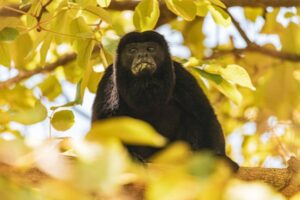
Amidst the dense foliage, the Howler Monkey adds its distinctive voice to the cacophony of the rainforest.
Its haunting calls resonate through the trees, creating an ethereal ambiance.
The Howler Monkey’s social nature and close-knit family units underscore the importance of unity in this intricate web of life.
Green Iguana
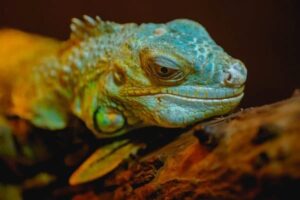
Basking in the dappled sunlight, the Green Iguana assumes the role of a noble guardian.
With its ancient, dinosaur-like appearance, this arboreal reptile surveys its domain with a calm demeanor.
The Green Iguana symbolizes resilience, adapting seamlessly to the ever-changing conditions of the rainforest. It’s a testament to the harmony that exists between its inhabitants and their environment.
Jaguar
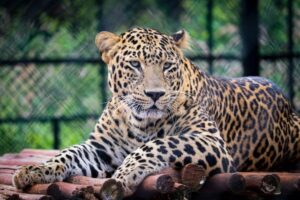
Stalking through the shadows, the majestic Jaguar reigns as the undisputed monarch of the rainforest.
Its sleek coat and powerful presence command respect, embodying the apex predator that keeps the delicate balance of the ecosystem intact.
The Jaguar’s golden eyes gleam with intelligence, a reminder of the intricate web of life that weaves through the heart of the Amazon.
Squirrel Monkey
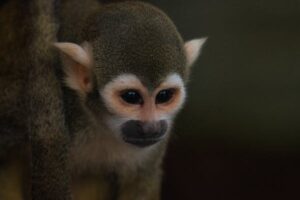
Swinging through the branches with boundless energy, the Squirrel Monkey epitomizes the spirit of curiosity.
These agile acrobats cross the canopy with elegant precision, their expressive faces reflecting a sense of mischief.
It is quite energetic and quick in fooling you, creating a joyous environment around you. The Squirrel Monkey’s tricks bring a sense of joy to the rainforest, reminding us of the vitality that dwells within this rich habitat.
Tapir Mammal
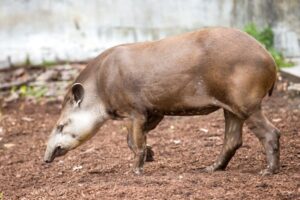
On the forest floor, the Tapir Mammal roams with a gentle grace, its distinctive snout probing the earth for sustenance.
As a symbol of resilience and adaptation, the Tapir Mammal navigates the challenges of its environment.
Thus embodying the spirit of endurance that characterizes life in the rainforest.
Caiman
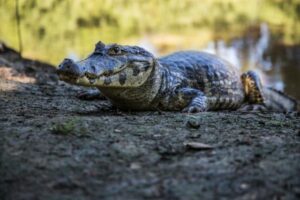
Slithering through the waterways, the Caiman, a prehistoric survivor, patrols the murky depths with a watchful eye.
This reptilian sentinel plays a crucial role in maintaining the ecological balance.
It showcases the interconnectedness of all species, even those belonging to different species families, within the rainforest.
Capybara
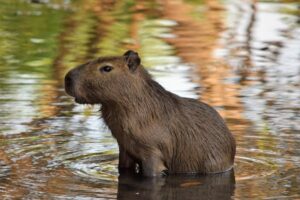
Amidst the lush vegetation, the Capybara, the world’s largest rodent, embraces its role as a gentle giant.
Its affable nature and communal living reflect the sense of community.
It binds the diverse inhabitants of the Amazon Rainforest together.
Toco Toucan
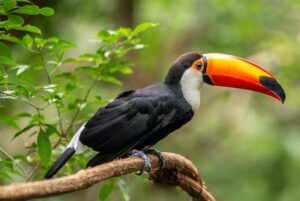
High above in the canopy, the Toco Toucan flaunts its colorful beak like a work of art.
With a playful demeanor, this avian ambassador flits from branch to branch, representing one of the many stunning birds of the Amazon.
Its vibrant feathers add a splash of brilliance to the emerald-green surroundings.
A lively chatter emanates from the Toucan, echoing through the treetops and contributing to the symphony of sounds that defines the Amazon Rainforest.
People in Amazon
Nestled within the heart of the Amazon Rainforest, the resilient people continue to live here for centuries in harmony with the vibrant ecosystem that surrounds them.
The indigenous communities weave their lives into the very fabric of the rainforest. Guided by traditions passed down through generations, these communities engage in sustainable practices.
Related Pick:
They draw sustenance from the rich biodiversity that thrives in their midst.
30 million people, including 350 indigenous and ethnic groups, are the inhabitants of the Amazon. They rely on nature for agriculture, clothing, and traditional medicines. Though most people live in large urban centers, all residents rely on the Amazon’s natural resources for food, dwelling, and livelihoods.
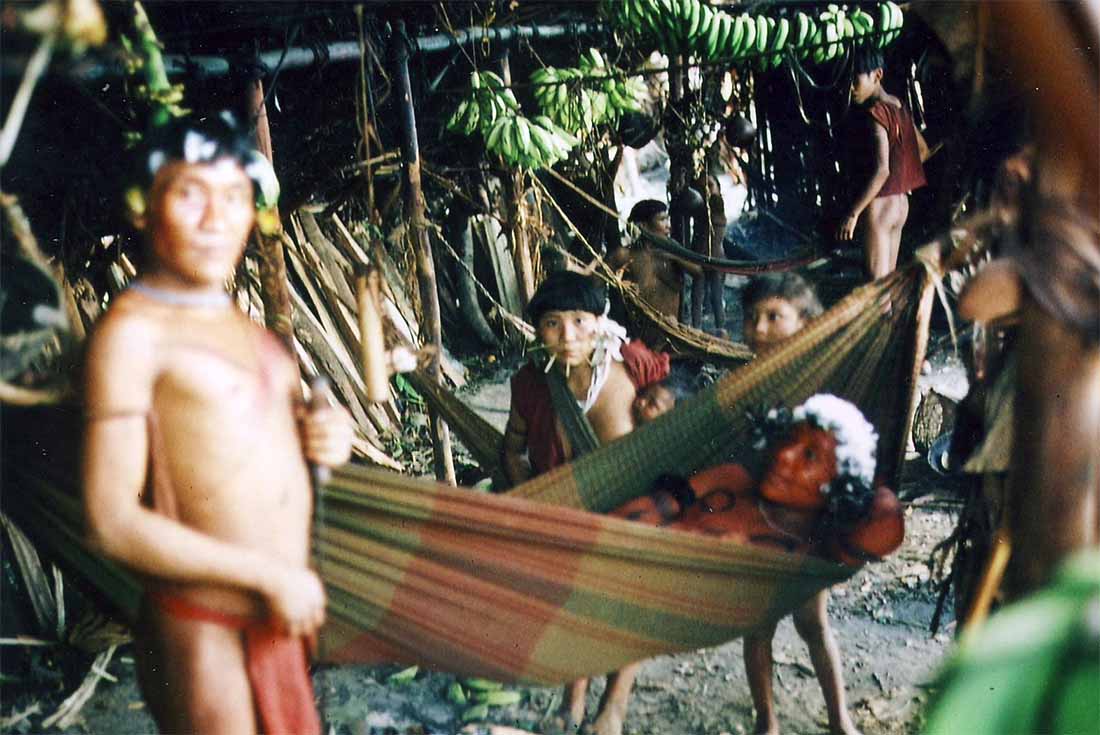
People in the Amazon eat fish, meat, root vegetables, and fruits. But, gradually Amazon is getting recognition for its vibrant, different, and ever-evolving cuisines.
In the face of contemporary challenges like deforestation and encroachment, these Amazonian people stand as guardians. These are majorly caused by unsustainable practices such as agricultural expansion and soil erosion. Preventive measures are crucial for not just their cultural heritage but also the delicate ecological balance that sustains life in the rainforest.
Deforestation in the Amazon Rainforest and Brazil
The Amazon Rainforest is not just a global ecological treasure; it’s home to millions of people, many of them indigenous tribes. Deforestation threatens their homes, traditions, and…
Their intricate knowledge of medicinal plants and sustainable agricultural techniques underscores their wisdom. That is deeply rooted in the rhythms of nature.
The global community increasingly recognizes the invaluable role of indigenous voices in conservation efforts.
As there is a growing commitment to supporting and empowering these communities, they are acknowledging that the preservation of the Amazon Rainforest is inseparable from the well-being of the people who have been its custodians for generations.
Famous Fruits of Tropical Rainforest Jungle
In the heart of the Amazon Rainforest, a tantalizing array of fruits beckons, each a testament to the rich biodiversity and exquisite flavors that define this lush realm.
Açaí Palm
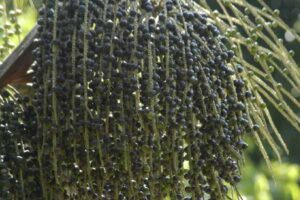
Among the towering trees and dense foliage, the Açaí palm stands as a symbol of vitality.
Its deep purple berries, harvested by the hands of locals, embody the essence of health and sustenance.
Communities gather beneath the sprawling fronds, sharing stories and savoring the energy-packed Açaí berries that weave a narrative of nourishment and communal connection.
Camu Camu
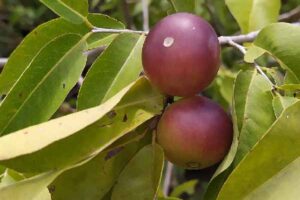
Beneath the jungle canopy, the Camu Camu tree offers a burst of citrusy vibrancy.
With its small, round fruits rich in vitamin C, the Camu Camu becomes a source of vitality for those who pluck its bounty.
Amidst the vibrant chatter of the rainforest, locals appreciate the Camu Camu not only for its nutritional value but also for the zest it adds to their daily lives, a small yet potent reminder of the abundance nature provides.
Passion Fruit
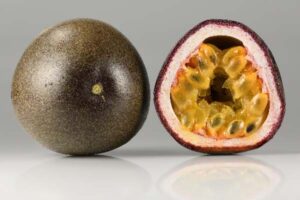
The Passion fruit, with its wrinkled exterior and luscious interior, is a tropical delicacy that captivates the senses.
As locals slice through the tough rind to reveal the succulent seeds within, they engage in a ritual that goes beyond mere sustenance; it is a celebration of nature’s bounty and a connection to the earth that sustains them.
The aroma of ripe Passion fruit permeates the air, creating a sensory experience that transcends the ordinary.
Cacao Tree
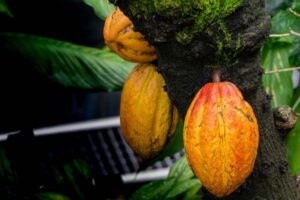
Beneath the emerald canopy, the Cacao tree gives birth to the precious beans that bring forth the rich, velvety goodness of chocolate.
As hands carefully harvest the cacao pods, there is an acknowledgment of the intricate journey from tree to treat.
The cacao bean becomes a conduit of pleasure, a culinary treasure that carries the essence of the rainforest to connoisseurs around the world.
Solanum Sessiliflorum
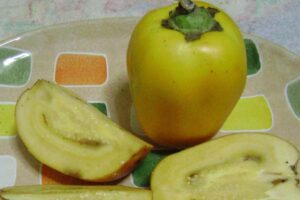
Amidst the foliage, the Solanum sessiliflorum, with its vibrant yellow berries, adds a burst of color to the landscape.
As hands pluck the fruits from the branches, there is an appreciation for the natural artistry that the rainforest paints with its diverse palette.
These small, sun-kissed orbs become a source of delight, a testament to the beauty that thrives in every corner of the Amazon.
Mauritia Flexuosa
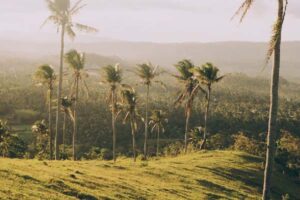
The Mauritia flexuosa, or aguaje palm, stands tall with its scaly, reddish-brown fruits.
As local communities gather beneath its lofty fronds, the aguaje becomes a source of sustenance and cultural significance.
The sweet, pulpy flesh is not just a flavor; it is a connection to traditions that have withstood the test of time, a reminder that the bounty of the rainforest is both a gift and a heritage to be cherished.
Noni
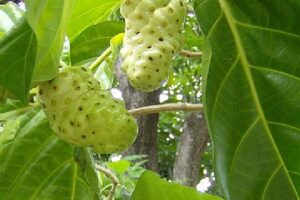
The Noni, with its distinctive knobbly appearance, adds a touch of the exotic to the rainforest’s fruit symphony.
As hands cradle the Noni, there is a recognition of its potential health benefits and a sense of curiosity about the mysteries it holds.
In the tapestry of Amazonian fruits, the Noni becomes a conversation starter, a unique thread in the fabric of exploration and discovery.
Banana Passionfruit
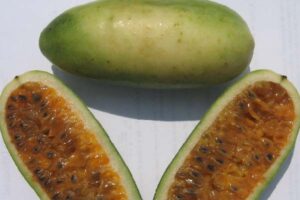
The Banana Passionfruit, with its elongated shape and aromatic allure, brings a tropical twist to the rainforest bounty.
As hands peel back the skin to reveal the treasure within, the fragrance becomes a sensory journey, evoking the essence of the Amazon in every bite.
The Banana Passionfruit is more than a fruit; it is an invitation to savor the sweetness of life in the heart of the jungle.
Cocoa bean
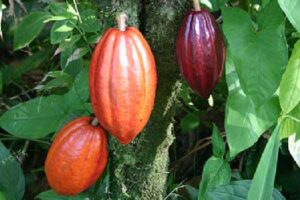
Lastly, the humble Cocoa bean, a cornerstone of global indulgence, begins its journey in the intricate ecosystem of the Amazon Rainforest.
As it undergoes the transformation from bean to bar, there is a recognition of the hands that cultivate this precious commodity.
The Cocoa bean becomes a symbol of the delicate dance between tradition and modernity, a sweet reminder that the rainforest is not just a source of flavors but a reservoir of stories waiting to be savored.
In the Amazon Rainforest, these fruits tell a story of sustenance, tradition, and the delicate interplay between humanity and nature.
Each bite is a celebration, each harvest a dance with the rhythms of the rainforest, forging a connection that transcends the ordinary and enriches the tapestry of life in this extraordinary ecosystem.
Activities in the Rainforest
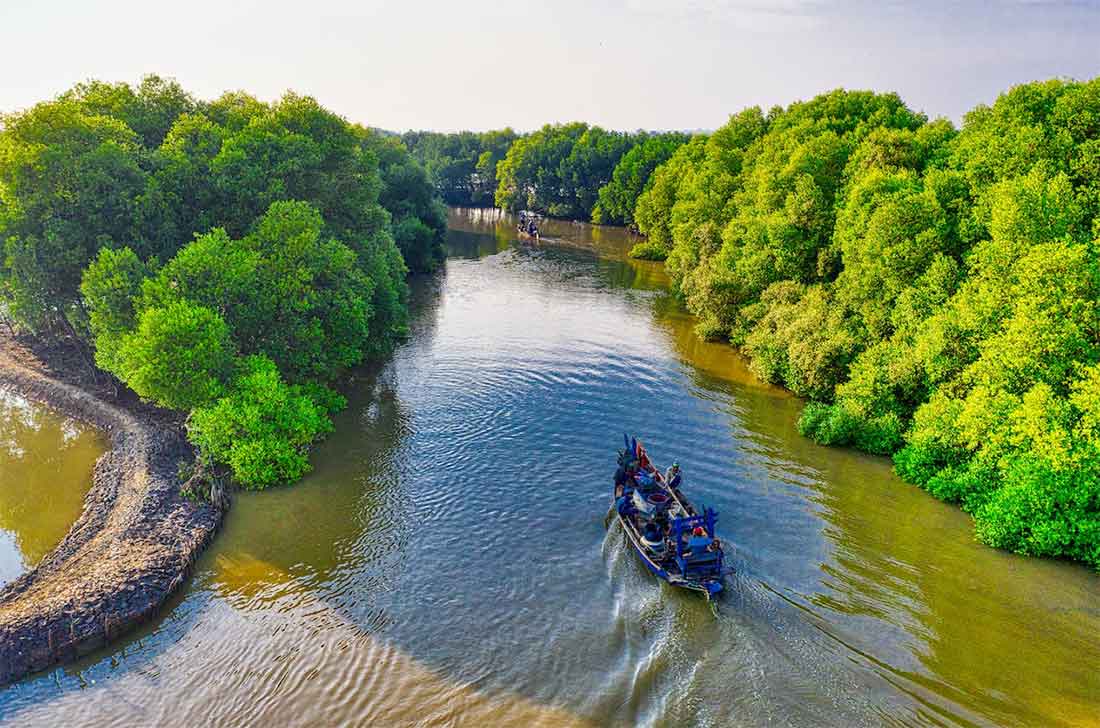
Embarking on an adventure into the Rainforest is like stepping into a living. This extraordinary journey is not just a visit; it’s a chance to connect intimately with the lush, vibrant ecosystem.
Imagine the thrill of standing on the edge of the Amazon River, fishing for piranhas, or sharing laughter with indigenous communities. The Amazon Rainforest beckons with a promise of immersive experiences, inviting you to not only witness its beauty but to become a part of its living, breathing story.
Amazon is the Largest rainforest in the World, explore the largest rainforests around the globe.
Here, the activities are not just excursions; they are opportunities to forge a profound connection with the captivating soul of the Amazon.
Jungle Walk in Rainforest
A jungle walk is a wonderful experience you will go through in the Amazon rainforest. You’ll not only see the unique wildlife but also learn about the various medicinal and unique plants in Amazon that have been used for years.
The sounds of nature work as a therapy specifically for elders who travel after retirement in search of peace and prosperity, away from the chaos of rushed cities.
You will also see anaconda snakes, tarantulas, poison dart frogs, rubber trees, and pineapple flowers on the ground.
Moreover, if you look up, you will see a three-toed sloth hanging from a tree, or a group of squirrel monkeys jumping through the rainforest canopy. It’s an arduous task to predict exactly what animals you’ll see in the Amazon rainforest.
Related Pick: A Comprehensive Guide for Animals that Camouflage
Piranha Fishing
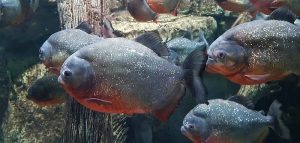
It’s a favorite activity in the Amazon River. Fishing for the rare piranha red-bellied typically occurs in the afternoon, from a skiff.
Though people use a traditional wooden rod an Amazon cruise guide will also provide them with bait. Moreover, most guests return the piranhas back into the river.
Local Community Visit
Getting the opportunity to visit a local Amazonian community is an extremely rewarding experience. You will interact with locals and get to know about their lifestyle in the Amazon rainforest. However, some cruises visit the Bora Community, an Amazonian tribe that continues most of their original beliefs and customs.
Moreover, visit their ceremonial lodge, called the Maloca, and witness an exhilarating, and traditional dance performance.
Swimming with Pink River Dolphins
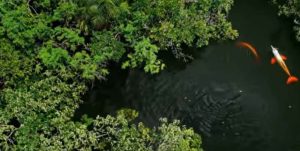
You will see pink river dolphins in the Amazon. While onboard the Desafio Amazon Cruise in Brazil, travelers will visit a floating pier.
Where they can trudge in the water, while fish are offered to pink river dolphins.
Additionally, it’s very exciting to be up close to these prehistoric-looking creatures!
Stand Up Paddle-Boarding
People in the Amazon riverboat can now enjoy the very popular stand-up paddleboarding (SUP) activity on the Amazon River in Peru. This water sport begins in Hawaii; It’s a cross between surfing and canoeing, on a large and stable surfboard that can be paddled.
The Amazon River is perfect for SUP since the water is calm, making it easy to balance and paddle. Plus, you’ll be able to explore areas of the Amazon that are not navigable by boat!
Kayaking in Tropical Jungle

Amazon River cruises offer kayaking, which allows the tourists to paddle in the most remote areas of the rainforest; where you will observe the magnificent flora and fauna of the Amazon.
Though Kayak trips are often the first thing happening in the morning, the main bird watches an hour and safely enjoys this extraordinary rainforest experience.
Canopy Bridge Walk in Amazon
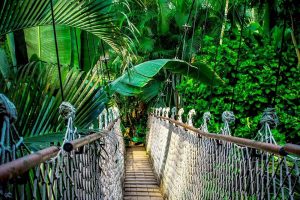
Immerse yourself up high in the jungle canopy. Most wildlife of the Amazon lives at the top of the forest. Some people will take the 500m walk across the La Posada canopy bridge in the Pacaya Samiria National Reserve.
You will get a unique view of the ecosystem at a height of over 25m / 85ft. The walkway is one of the longest in the world that is hung between 14 large trees and there are no special skills or tools are needed to enjoy it or adore the view.
Swimming in the Amazon
If you are brave enough, jump into the Amazon River and go for a swim! Most Amazon cruises make time for swimming adventures!
Manatee Rescue Center
Most Peruvian Amazon River cruises make a stop at the Manatee Rescue Centre just outside of Iquitos. Here, young manatees are rescued from the pet trade and are raised by staff.
However, orphaned and injured animals are cared for and rehabilitated. To be released back into the rainforest. At the Manatee Rescue Centre, tourists will also be able to feed young manatees and spend time with sloths, anteaters, and monkeys.
National Parks
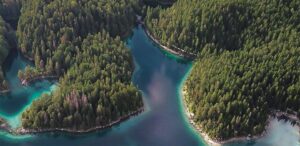
The Amazon rainforest is also home to many UNESCO World Heritage sites and National Parks. The Pacaya-Samiria National Reserve is the most pristine and bio-diverse area of the Peruvian rainforest.
Whereas in Brazil, the Anavilhanas Archipelago is a complex of over 400 unique islands in the middle of the Amazon.
In Ecuador, Yasuni National Park is extremely remote and has almost 2.5 million acres of untouched wilderness from rainforest to marshlands. It’s also home to a number of Amazonian tribes, such as the Taegari tribes.
Take Aways
The Amazon Rainforest spans over 6.7 million square kilometers across nine nations. It is a breathtaking tapestry of life, hosting an estimated 9.5% of the world’s species.
The indigenous communities, numbering around 30 million people, have harmoniously lived within the rainforest for centuries. They rely on its rich biodiversity for sustenance and cultural practices.
Their resilience is crucial in the face of modern challenges like deforestation, as they serve as guardians. There are several causes of deforestation related directly to the Amazon basin of South America and its biodiversity.
Read About How Does Deforestation Affect the Carbon Cycle?
Beyond its biological richness, the rainforest offers a plethora of activities. From jungle walks and piranha fishing to interacting with local communities and swimming with pink river dolphins.
As the global community recognizes the crucial role of indigenous voices in conservation, a commitment to supporting and empowering these communities is growing. Acknowledging that the preservation of the Amazon Rainforest is intricately linked to the flourishing of both its inhabitants and its extraordinary biodiversity.
References:
1: Da Silva, José Maria & Rylands, Anthony & Fonseca, Gustavo. (2005). The Fate of the Amazonian Areas of Endemism. Conservation Biology. 19. 689 – 694. 10.1111/j.1523-1739.2005.00705.x.
2: Lewinsohn, Thomas & Prado, Paulo. (2005). How Many Species Are There in Brazil?. Conservation Biology. 19. 619 – 624. 10.1111/j.1523-1739.2005.00680.x.
